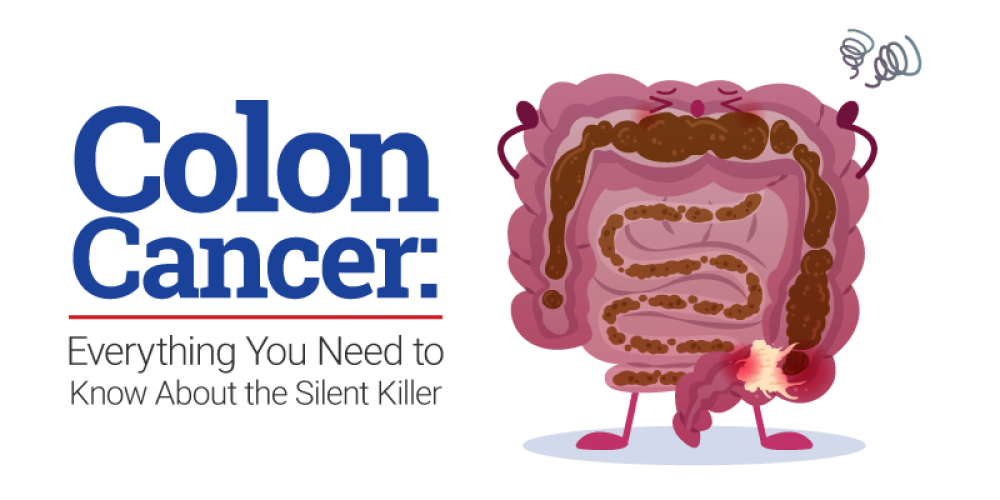Perhaps most of you know a person who had suffered from cancer or is still fighting this deadly disease through frequent visits to a cancer center. The situation can more likely be bleak if the patient is afflicted and detected in its advanced stages with one of the silent killers known as colorectal cancer (CRC), or more commonly known as colon cancer.
This type of cancer starts as small polyps inside the wall of the rectum or large intestine, and produce little to no symptoms, giving it the reputation of being a silent killer. For this reason, it is recommended that you take regular screening tests to help you prevent the progression of the disease. This can be done by identifying and surgically removing the polyps before they turn into cancer.
Colon cancer is highly prevalent in the US, with nearly 137,000 people diagnosed each year and over 50,000 succumbing to the disease annually. Despite these overwhelming numbers, the good news is that colon cancer is preventable, treatable, and beatable. Like other types of cancer, patients have a higher cure rate when colon cancer is detected and treated early.
Colon cancer isn’t as formidable as it is known to be, as long as you are cautious and vigilant about its prevention and early detection. To help arm you with the necessary information about the disease, here are the facts that you need to know:
It is clear that colon cancer is one of the top silent killers due to the absence of symptoms until the later stages. The mortality rate is high, so it’s vital to know how to take care of your body and prevent this deadly disease. It’s also crucial to undergo screening tests, particularly if there are risk factors involved, so the cancer can be detected early on and increase your chances of survival with the right treatment.
The Cause
Up until today, doctors aren’t certain of what causes most colon cancers. Generally, colon cancer begins when healthy cells in the colon undergo mutation in their DNA, which contains a set of instructions telling a cell what to do.
Normally, healthy cells grow and divide in a methodical way to keep your body functioning properly. However, when a cell’s DNA is damaged and becomes cancerous, the cells continue to divide even if new ones aren’t needed. As they amass, a tumor is formed.[JAG3] [KKM4]
Risk Factors
Since the exact causes are unknown, there are a number of predisposing and risk factors to consider that may increase the chances of having colon cancer. Medical history and genetics play a crucial role here, so if you have family with a history of cancer or inflammatory bowel disorders, it would be prudent to have regular screening checks for early detection. This also applies if you maintain an unhealthy lifestyle, such as heavy smoking and drinking alcohol, eating a low-fiber and high-fat diet, and not being physically active.
Signs and Symptoms
Despite showing little to no symptoms, you should pay close attention to even the subtlest signs. Remember, early detection gives you an edge in your fight against this disease, so keep an eye on any abnormalities in your body. Your bowel movement and the consistency of your stool can speak volumes. One of the most crucial signs is blood in your stool. Combined with persistent fatigue and weight loss, it’s time to have yourself checked when these occur.
Colon Cancer Screening
There are a variety of methods when screening for colon cancer, with each having its advantages over the other.
When blood is found in stool, there are two tests that could be done to detect the presence of colon cancer: the fecal occult blood test (FOBT) and stool DNA test (FIT-DNA). The difference is, FIT-DNA is more comprehensive in a way that it detects DNA biomarkers in three genes that have been found in colon cancer.
Colonoscopy and Sigmoidoscopy
If blood in stool has been confirmed as a high risk to have colon cancer, the next most common method is a colonoscopy. It’s an invasive procedure where a long flexible endoscope is inserted into the rectum through the anus to check for polyps, helping doctors gain a visual diagnosis and an opportunity to perform a biopsy.
A colonoscopy is a better procedure as opposed to a sigmoidoscopy, where only the lower part of the rectum can be examined. However, technology has found less invasive ways to check for polyps before having to proceed with a biopsy. There is the virtual colonoscopy that uses a CT scanner, and the double-barium enema through an enema containing a barium solution for a better view of the colon and rectum in x-rays.[JAG5] [KKM6]
Stages of Colon Cancer
After screening and confirming the presence of colon cancer, doctors will assess its growth by stage. Generally, the five-year survival rate of people suffering from colon cancer is 65 percent, which varies by stage. The localized stage gives patients a 90 percent survival rate. If it has spread to surrounding tissues or organs and lymph nodes, their five-year survival rate is 71 percent. But if it has reached the distant parts of the body, the five-year survival rate is 14 percent. However, if there are only a few tumors that have reached the lungs or liver, surgical removal can eliminate the cancer and improve the five-year survival of these patients.
Treatment
Doctors with different specialties usually work together to create a patient’s overall treatment plant. This depends on factors such as the stage and location of the cancer, possible side effects, and the patient’s overall health.
Surgery is the most common treatment to remove the section of the colon with the cancer, and both traditional colectomy and laparoscopic surgery can be performed to do this. The latter is a minimally invasive procedure that involves viewing scopes inserted into the abdomen through small incisions to remove the section that has cancer.
In cases when the cancer is in the rectum, a colostomy is needed. After removing the section of the rectum with the cancer, a surgical opening called a stoma is used as a pathway for waste to exit the body while the rectum heals. It may be temporary or permanent, but modern surgical techniques and treatment have most patients not needing a permanent colostomy.
Chemotherapy
Chemotherapy is another common treatment, which involves the use of drugs to destroy the cancer cells, usually by eliminating their ability to grow and spread. A specific number of cycles are given over a set period of time.
Radiation Therapy
Patients with cancer in the rectum are usually given radiation therapy, which uses high-energy x-rays to destroy the cancer cells. This is done since this kind of cancer tends to recur near where it first started. In some cases, radiation therapy may be used to shrink the cancer before surgery for easier removal.
Targeted Therapy
In a targeted therapy procedure, the treatment focuses on the cancer’s specific genes, proteins, or tissue environment that helps in the cancer’s growth. Doctors may run tests to identify these factors in the tumor and find the matching treatment using drugs, antibodies, and other methods whenever possible.
Immunotherapy
Immunotherapy uses immune checkpoint inhibitors, which are drugs designed to block certain proteins made by cancer cells. This helps boost the body’s natural defenses to fight the disease and restore immune system function.
Prevention
As with any disease, prevention is always better than cure. If you have the risk factors, it would be prudent to stick to a healthy regimen. Eat more fruits, vegetables, and whole grain foods to get the needed fiber to aid digestion. Refrain from smoking and drinking alcoholic beverages, and start working out to maintain a healthy weight. The key is to have a healthy lifestyle and outlook, which includes proper nutrition and exercise.
It’s Not a Losing Battle
Despite its reputation of being a silent killer, colon cancer doesn’t have to live up to it. There are effective ways to prevent and cure this disease if detected early. You will always have the upper hand if you keep it in check. The best way to handle this is to visit MakatiMed’s Cancer Center for colorectal cancer screening. This is vital if you are at risk or if you already have some of the signs and symptoms. Remember, early detection can give you the highest chance for recovery and survival.












